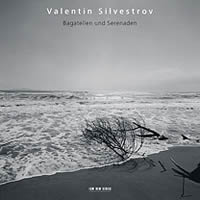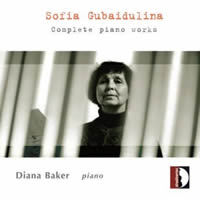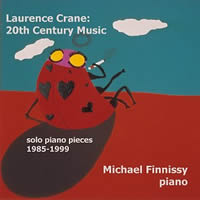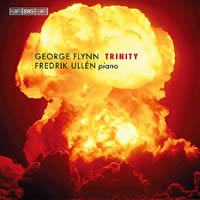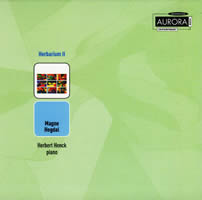Piano Factory 1.
|
Grant Chu Covell [September 2008.]
“Nostalghia.” Valentin SILVESTROV: Nostalghia (2001); Two Pieces (2001); Two Dialogues with an Epilogue (2001-2); Three Postludes (2005); Three Pieces (2001); Two Pieces (2003); Three Waltzes (2005); Sonata No. 1 (1972); The Messenger – 1996 (1996-97). Jenny Lin (pno). Hännsler Classic CD 98.229 (http://www.haenssler-classic.com/). Distributed in the US by Allegro Music (http://www.allegro-music.com/). “Bagatellen und Serenaden.” Valentin SILVESTROV: Bagatellen (2005); Elegie (2000-02); Stille Musik (2002); Abschiedsserenade (2003); Der Bote (1996); Zwei Dialog mit Nachwort (2001/02). Valentin Silvestrov, Alexei Lubimov (pnos), Münchener Kammerorchester, Christoph Poppen (cond.). ECM 1988 (http://www.ecmrecords.com/). Having negotiated the 20th century’s main styles, Silvestrov abandons them for an introspective Romantic cloud. Most of his piano works are aphoristic-atmospheric ruminations cradling older music, such as the lovingly ersatz Mozart in The Messenger – 1996, written after his wife’s sudden death (which was absorbed into the Requiem), or explicitly, as in Schubert’s Kupelwieser waltz. (Schubert played the waltz at a friend’s wedding but never wrote it down. It was transmitted by memory through generations of Kupelwiesers until Richard Strauss put it to paper.) Silvestrov’s diatonic melodies can splutter like a toddler’s first words: cute yet awkward as Silvestrov breaks common-practice tonality’s rules and regulations. The Three Waltzes, dedicated to Schoenberg, Webern and Berg, step back into atonality. The 1972 sonata fits well among later Silvestrov, despite its modernist aspirations. Lin is recorded at close up. She has the right manner to make the Romanticism sing (the Schubertian Three Postludes) and the gauzy time-warp convincing. ECM offers bittersweet combinations of solo piano and strings, sad-puppy precious and insubstantial. Der Bote arranges The Messenger for piano and strings, perhaps Silvestrov’s most frequently recorded piece. Zwei Dialog mit Nachwort appears for piano and strings. The remaining works are for string orchestra. I half expected a synthesizer and bongos to intrude in the moody Elegie, whereas Stille Music could slide into Mahler without raising a brow. Silvestrov himself takes to the piano, dallying through several solo, quasi-improvisatory Bagatelles, lovesick echoes of 19th-century songs without words. The instrument’s blurred resonances suggest its having been taped within a huge cistern. Silvestrov adherents will think this absolutely necessary (and they will be wrong).
“Complete Piano Music.” John ADAMS: Phrygian Gates (1977-78); American Berserk (2001); China Gates (1977); Hallelujah Junction (1996). Ralph van Raat, Maarteen van Veen (pnos). Naxos 8.559285 (http://www.naxos.com/). An esteemed forebear in minimalism’s extended family, Adams took some time to progress beyond self-important glacial droning into an assured, perkily ironic, historically aware style. At a longish 24 minutes, Phrygian Gates labors through its material. In the recent American Berserk, procedural rigor gives way to Nancarrow-infused, bopping joy. Van Raat takes the three solos in a smooth, deep-pedaled style that over-inflates Phrygian Gates yet suits the terser China Gates. I associate a crisper delivery with these earlier pieces, perhaps because my favorite early Adams is the chiseled Shaker Loops (1978), for string orchestra, while the blurring washes of subsequent orchestral scores such as Harmonielehre (1984-85) might owe to van Raat’s inspirations. Hallelujah Junction is a grand two-piano tintinnabulation, an anxious train chuffing through gradually coarsening terrain.
“Complete Piano Works.” Sofia GUBAIDULINA: Chaconne (1962); Sonata (1965); Musical Toys (1969); Toccata-Troncata (1971); Invention (1974). Diana Baker (pno). Stradivarius STR 33756 (http://www.stradivarius.it/). Distributed in the US by Allegro Music (http://www.allegro-music.com/). Gubaidulina’s piano works reveal one of the 20th century’s most inventive and independent-minded composers. The 1962 Chaconne assimilates traditional forms with the brusque rhythms and unexpected harmonies that anticipate the 1965 Sonata’s clusters, inside-piano sounds, jazz and gestures reminiscent of Prokofiev’s Scythian. Where the Sonata is serrated and bleak, the 14-part Musical Toys is pithy in the tradition of Mikrokosmos, though, as in many fairy tales, evil lurks in the forest. Two crisp perpetual motions, Toccata-Troncata and a one-minute Invention, close the program.
Minas BORBOUDAKIS: Metal Mechanics I-V (2006); Zykloiden I (2006); Palindromia (2004); Sechs Gedanken (2002-03); Katharsis (2002); 1945. Nachklänge der Vergangenheit (1995). Minas Borboudakis (pno). NEOS 10701 (http://www.neos-music.com/). Distributed in the US by Qualiton (http://www.qualiton.com/). Five taped “electronic intermezzo[s]” interleave and bracket a reverse chronological tour across Borboudakis’ aesthetic. The piano works exhibit influences from jazz, Nancarrow and Ligeti, along with a desire to thrash between extremes, most prevalent in the recent Zykloiden I and Palindromia. The older pieces, while vigorous, are less abstract, poetic even. Katharsis buries Liszt references (I hear Stockhausen too). Reminiscent of Schaeffer’s early etudes, the electronic series Metal Mechanics manipulates piano sounds. These tape works strike this listener as the most inventive, which is not to slight Borboudakis’ playing.
Laurence CRANE: 20th Century Music (1999); Three Preludes (1985); Blue Blue Blue (1986); Kierkegaards (1986); Birthday Piece for Michael Finnissy (1996); Derridas (1985-86); Gorm Busk (1991); James Duke son of John Duke (1989); Looking for Michael Bracewell (1989); Andrew Renton becomes an international art critic (1989); Chorale for Howard Skempton (1997); Three Pieces for James Clapperton (1989). Michael Finnissy (pno). Metier MSV28506 (http://www.divine-art.com/). Spanning 1985 to 1999, Crane’s solo piano works cultivate a consistent style, easily pigeon-holed as minimal, but more like rambling ruminations on Satie’s left-hand accompaniments. Crane supplies repeated chords in sequences with plain diatonic melodies, or sometimes none at all. The opening 20th Century Music recalls a music-school gag: playing the examples in a music theory textbook. While within a given example chords resolve properly, a subsequent example in a jarringly different key assaults the ear. (This reminds me of a set of throwaway pieces I based on Brahms waltz excerpts stripped of accidentals.) Clearly, Crane takes pleasure in his titles: Jacques Derrida goes to the supermarket might not provoke giggles, but it certainly suggests a kind of plateau: Imagine deconstruction’s beleaguered parent at a nightclub, in a massage parlor, buying groceries, or on a beach. Crane, who never met music historian Gorm Busk, fancied the sound of his name. Most pieces portray friends and colleagues. Expanses of evenly voiced chords offer opportunities for subtlety, as with Prelude No. 3’s fade-away and the momentarily quickening pace in Blue Blue Blue.
Thierry PÉCOU: L’Oiseau innumérable (2006); Outre-mémoire, variances (2004); Petit Livre pour clavier (1995); Après Rameau, une sarabande? (2001). Jean-Philippe RAMEAU: Sarabande (1728). Alexandre Tharaud (pno, org, spinet, clavichord), Ensemble orchestral de Paris, Andrea Quinn (cond.). Harmonia Mundi HMC 901974 (http://www.harmoniamundi.com/). There are few concertos in Tharaud’s discography. This release creates an appetite for more. Pécou’s exceptional concerto, L’Oiseau innumérable, blends French orchestral panache with Bartók and Stravinsky’s barbaric energies. (I suspect that the fourth movement conceals Rite quotes.) Repetition — but not minimalism — is a recurring technique, from the second movement’s mechanistic rocking to the casual looping of unsteady motifs in the final movement of Outre-mémoire, variances. The concerto’s third movement conjures dark forest murmurs. One expects Mime to pop out from behind a rock. Harmonia Mundi captures crisp orchestral clarity. Outre-mémoire, variances, a solo-piano version of a work for piano, flute, clarinet and cello as reflections on the slave trade contains seven contrasting movements that echo African themes, balancing disquiet with majesty. The Petit Livre pour clavier collects five vignettes that document Pécou’s meanderings among Ferrara’s neglected church organs the dilapidation and idiosyncratic tunings of which proved inspirational. Tharaud plays these brief pieces on an assortment of instruments (positive organ, spinet and clavichord), their quirky, unfamiliar timbres enhancing awkwardness by way of a bemused charm. Pécou’s final entry on the program, Après Rameau, une sarabande?, a lightly treading scepter, disguises any connection with the Baroque composer. When the lagniappe does arrive, Rameau’s Sarabande from the 1728 Nouvelles Suites, the effect has the listener emerging from a matinee into bright sunlight.
“Trinity.” George FLYNN: Kanal (1976); Wound (1968); Salvage (1993). Fredrik Ullén (pno). BIS CD 1593/94 (http://www.bis.se/), 2CDs with mp3 files and score. Distributed in the US by Qualiton (http://www.qualiton.com/). Savage and pessimistic, Flynn’s Trinity concerns itself with warfare and violence. Kanal was inspired by Andrzej Wajda’s film about the 1944 Warsaw uprising. Wound is a reaction to political events in the late 1960s in Vietnam and the United States. Salvage seeks and almost begrudgingly finds resolution, borrowing imagery from T.S. Eliot’s Four Quartets. Flynn’s maximal writing churns pounding chords and arpeggiated cascades. You sense that he might know something about beauty but chooses to keep it at arm’s length. Ullén — no stranger to complexity, having recorded Ligeti and Sorabji for BIS — administers brutality, while permitting sensitivity in those few places where it’s required. The epic’s complete score lives on the second disc.
Magne HEGDAL: Herbarium II (1974/2002). Herbert Henck (pno). Aurora ACD 5041 (http://www.mic.no/english, http://www.komponist.no/). Its title implying a scientific collection, Hegdal’s Herbarium II offers 57 pithy “flowers,” grouped in six families with a final set of doubles and variants. Henck’s notes reveal the composer’s method, “a strict mechanical process based upon chance operations.” Quite so. Everything seems directed by some obscure, non-musical concept. No movement exceeds two minutes, with most approximating a minute of non-repeating, undeveloped material. Inevitably, the mind tries to organize and arrange and, aware of the scope of possible alternates, attempts to shoe-horn these quirky, remorseless items into some sort of logic or order. Because everything passes quickly, continuity remains elusive. You won’t be tempted to hit your player’s shuffle button. The notes hint at influences: Anton Reicha wrote an Op. 57 set of 57 variations, with Josef Matthias Hauer hovering at an obscure distance. As for Cage’s guiding hand, this assemblage lacks his whimsy.
[More Grant Chu Covell, Piano Factory]
[Previous Article:
What, More Words? 1.]
[Next Article:
Not So Good Conducting, Worse Composing]
|

